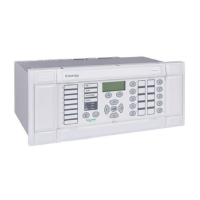P54x/EN SC/La4 SCADA Communications
(SC) 13-14
MiCOM P543, P544, P545 & P546
SC
The default setting is to select the electrical (copper) connection. If the optional fiber optic
interface is fitted to the relay, then this setting can be changed to ‘Fiber optic’. This cell is
invisible if a second rear communications port or an Ethernet card is fitted, as they are
mutually exclusive and occupy the same physical location.
The following cell which may be displayed, is not currently used but is available for future
expansion
RP1 InactivTimer
The next cell down can be used for monitor or command blocking:
RP1 CS103Blocking
There are three settings associated with this cell; these are:
Disabled - No blocking selected.
Monitor Blocking - When the monitor blocking DDB Signal is active high, either by
energizing an opto input or control input, reading of the status
information and disturbance records is not permitted. When in
this mode the relay returns a “Termination of general
interrogation” message to the master station.
Command Blocking - When the command blocking DDB signal is active high, either by
energizing an opto input or control input, all remote commands
will be ignored (i.e. CB Trip/Close, change setting group etc.).
When in this mode the relay returns a “negative
acknowledgement of command” message to the master station.
1.3.5 Configuring the DNP3.0 rear port, RP1 and optio
nal DNP3.0 over Ethernet
The DNP3.0 protocol is defined and administered by the DNP User Group. Information
about the user group, DNP3.0 in general and protocol specifications can be found on their
website: www.dnp.org
The DNP3.0 implementation in the MiCOM P54x can be presented on an EIA(RS)485
physical layer, and/or on an Ethernet connection according to the options selected.
The settings applicable to the EIA(RS)485 implementation are described in section 1.3.5.1.
The setting
s applicable to the Ethernet implementation are described in section 1.3.5.2.
The rel
ay operates as a DNP3.0 slave and supports subset Level 2 of the protocol plus
some of the features from Level 3.
1.3.5.1 Configuring the DNP3.0 {EIA(RS)485 presentation} rear port, RP1
DNP3.0
communication can be achieved via a twisted pair EIA(RS)485 connection to the
rear port and can be used over a distance of 1000 m with up to 32 slave devices.
To use the DNP3.0 communication, the relay’s communication settings must be configured.
To do this use the front panel user interface keypad, display, and menu software. In the
menu firstly check that the ‘Comms. Setting’ cell in the ‘CONFIGURATION’ column is set to
‘Visible’, then move to the ‘COMMUNICATIONS’ column. The settings that apply to the rear
port using DNP3.0, which are applicable to the EIA(RS)485 implementation are described
below. Move down the ‘COMMUNICATIONS’ column from the column heading to the first
cell that indicates the communications protocol:
RP1 Protocol
DNP3.0

